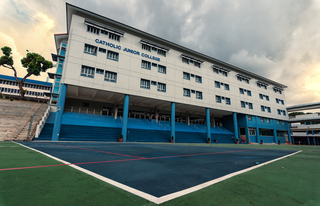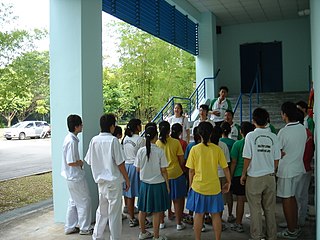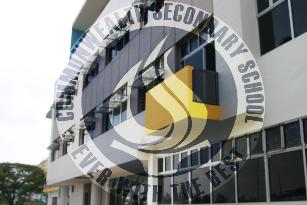Related Research Articles

Education in Singapore is managed by the Ministry of Education (MOE). It controls the development and administration of state schools receiving taxpayers' funding, but also has an advisory and supervisory role in respect of private schools. For both private and state schools, there are variations in the extent of autonomy in their curriculum, scope of taxpayers' aid and funding, tuition burden on the students, and admission policy.

National Junior College (NJC) is a government junior college located in Bukit Timah, Singapore. Established in 1969, it was the first government junior college in Singapore. NJC offers a two-year course for pre-university students and a six-year Integrated Programme, both leading to the Singapore-Cambridge GCE Advanced Level examinations. It is among top 5 junior colleges in the country in terms of minimum entry cut off points. Former Prime Minister of Singapore Lee Hsien Loong is among its notable alumni.

Temasek Junior College (TJC) is a government-run junior college temporarily located in Tampines. Its original location in Bedok South is currently undergoing reconstruction as part of the JC Rejuvenation Programme. It offers a six-year Integrated Programme alongside a two-year Singapore-Cambridge GCE Advanced Level curriculum.

Millennia Institute (MI) is a centralised institute in Singapore offering three-year pre-university education. It is currently the only pre-university centre to offer the Commerce stream apart from the traditional arts and science streams offered by pre-university institutions.

River Valley High School (RVHS) is a co-educational government autonomous secondary school in Boon Lay, Singapore. Founded in 1956 and originally located in River Valley, it is one of the Special Assistance Plan schools designated by the Ministry of Education in recognition of its heritage and excellence in education. Since 2006, the school has been running a six-year Integrated Programme that allows students to skip the Singapore-Cambridge GCE Ordinary Level examinations and proceed to sit for the Singapore-Cambridge GCE Advanced Level examinations at the end of Year 6.

Catholic Junior College (CJC) is a junior college in Singapore, offering a two-year course for pre-university students leading to the Singapore-Cambridge GCE Advanced Level examination. Founded in 1975, Catholic Junior College was the third junior college to be established in Singapore.

Jurong Pioneer Junior College (JPJC) is a junior college in Singapore offering a two-year pre-university course leading up to the Singapore-Cambridge GCE Advanced Level examination. The college was formed from the merger of Jurong Junior College and Pioneer Junior College in January 2019.

The Provisional Admission Exercise (PAE), colloquially known as the first three months among Singapore students, was an interim exercise in which graduating Secondary 4 students in Singapore could choose to join a junior college or centralised institute for Term 1 in the following academic year, before the official release of the GCE 'O' level results. Students used the score of their respective secondary schools' internal preliminary examinations to apply under the programme.

Commonwealth Secondary School is a government, autonomous and coeducational secondary school in Jurong East, Singapore. Founded in 1964, Commonwealth Secondary School offers secondary school education which leads to the Singapore-Cambridge GCE Ordinary Level or Singapore-Cambridge GCE Normal <Academic and Technical> Level examination.

Pei Hwa Secondary School (PHSS) is a co-educational government-aided secondary school in Fernvale Link, Singapore within walking distance of Fernvale and Layar LRT stations. Re-established in 2005, Pei Hwa Secondary School was first founded in 1934 as Pei Hwa Public School.
Holy Innocents' High School (HIHS) (Simplified Chinese:圣婴中学, Traditional Chinese: 聖嬰中學, pinyin: Shèngyīng Zhōngxué) is a Catholic school in Singapore. Founded in 1892, the school offers secondary school education leading up to a Singapore-Cambridge GCE Ordinary Level examination, in both the Express and Normal (Academic) streams, as well as Singapore-Cambridge GCE Normal Level in the Normal (Academic) and Normal (Technical) streams.
Junior colleges (JC) are pre-university institutions in Singapore that offer two-year pre-university courses that leads to either the Singapore-Cambridge GCE Advanced Level (A-Level) or the International Baccalaureate Diploma. Admission to junior college is based on attaining an aggregate raw score of 20 points or less in the O-Level examination.
The education system in Lahore is formulated along specific modern, religious, cultural, social, psychological, commerce and scientific injunctions. Lahore is Pakistan’s largest producer of professionals in the fields of science, technology, IT, engineering, medicine, nuclear sciences, pharmacology, telecommunication, biotechnology and microelectronics. Most of the reputable universities are public, but in recent years there has also been an upsurge in the number of private universities. The current literacy rate of Lahore is 64%. The standard national system of education is mainly inspired from the British system. The system also aims to imbibe a secular outlook among the students with the awareness of the rich cultural heritage of Pakistan. Lahore has a wide range of schools, colleges and universities that caters to diverse streams.
The Singapore-Cambridge General Certificate of Education Advanced Level is a GCE Advanced Level examination held annually in Singapore and is jointly conducted by the Ministry of Education (MOE), Singapore Examinations and Assessment Board (SEAB) and the University of Cambridge Local Examinations Syndicate (UCLES).
Bukit Merah Secondary School (BMSS) is a co-educational government secondary school in Bukit Merah, Singapore. BMSS has established itself as a Value-Added school since 1993, offering the Express, Normal Academic and Normal Technical streams leading to a Singapore-Cambridge GCE Ordinary Level or Singapore-Cambridge GCE Normal Level certificate.

Secondary education in Singapore is largely public, and is compulsory until a child has reached 16 years of age. At the end of public primary education, Singapore students take the Primary School Leaving Examination (PSLE) and are placed into the different streams and secondary schools based on their results. There are three main public secondary education streams: Express (E)(Currently known as G3), Normal (Academic), and Normal (Technical), with special and private education courses also being available. The Express stream has a more stringent cut-off than the Normal (Academic) stream, which is in turn more selective than the Normal (Technical) stream. Secondary students can move between streams based on their academic performance.
Tiong Bahru Secondary School, established in 1966 and merged with Delta Secondary School in 1991, was one of the first bilingual integrated (混合中学) secondary schools built after Singapore Independence. It had both Chinese and English streams, attracting students from nearby primary schools in Tiong Bahru, Bukit Ho Swee and Delta Road areas.

Chua Chu Kang Secondary School (CCKSS) is a co-educational government secondary school in Choa Chu Kang, Singapore. Founded in 1992, the integrated government school offers secondary education under three academic streams, which leads to the Singapore-Cambridge GCE Ordinary Level or the Singapore-Cambridge GCE Normal Level examinations. The school merged with Teck Whye Secondary School (TWSS) in 2023.
Yuhua Secondary School (YHSS) is a co-educational government school in Jurong West, Singapore which offers the Express, Normal (Academic) and Normal (Technical) streams. It was founded in 1986.
References
- 1 2 Chua, Chong Jin (18 October 1989). "Outram Institute's extra exams for students pay off". The Straits Times. Singapore. p. 18. Retrieved 30 November 2017.
- 1 2 "About MI". Millennia Institute. Archived from the original on 24 December 2017. Retrieved 30 November 2017.
- ↑ Law, Bernard (14 April 1987). "Outram needs name with stature". The Straits Times. Singapore. p. 18. Retrieved 30 November 2017.
- 1 2 "Townsville Institute". moehc.moe.edu.sg. Retrieved 20 January 2025.
- ↑ Braema Mathi (22 November 1995). "Falling demand, so 2 Pre-U centres to close in 2 years". The Straits Times. Singapore. p. 25. Retrieved 30 November 2017.[ dead link ]
- ↑ "Independent Junior Colleges, Merger of Centralised Institutes and Enhancements to Edusave Scholarships Framework" (Press release). Ministry of Education. 26 July 2003. Archived from the original on 26 September 2008. Retrieved 25 December 2016.
- ↑ Koh, Yvonne (3 December 2003). "New campus for merging centralised institutes". The Straits Times. Singapore.
- ↑ "2 schools celebrate landmark events". news.asiaone.com. Retrieved 25 December 2016.